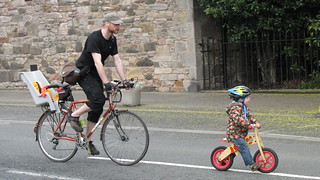OK, Livi. The paths vary in width, the main paths are similar in width to say the NEPN, some are wider. Once you get off of the main arteries, the paths can be 2m wide or less, so not very wide.
Regards to density, in Livingston there are a few areas around the town centre where the paths are well used, people seem to naturally cycle slower there.
In Edinburgh, there are a few streets in the city centre which are very dense with pedestrians. Once you get a few blocks away from the centre, they are pretty empty.
Edinburgh is in a grid system, Livingston is not.
Edinburgh has a lot of 'arteries' which allow cycling to / from the contre. These seem to function pretty well. Even the NEPN is pretty devoid of peds at peak commuting times. So even as close as Haymarket , the pavements are practically empty.
Even within the grid system, some pavements are well used where one street away is practically empty. Seems there is some cycle infa / shared paths just waiting to be implemented there...
Examples, Morrison St busy, Torphichen St, devoid of peds.
George St busy, Queen St devoid of peds
You just need to choose which streets to share. The one advantage of a grid system is that you can easily (with money and will) create directions of flow, and put different modes on different streets.

 posts
posts
